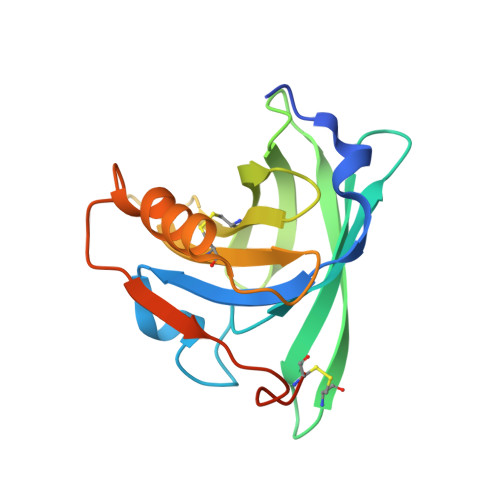The dimeric crystal structure of the human fertility lipocalin glycodelin reveals a protein scaffold for the presentation of complex glycans.
Schiefner, A., Rodewald, F., Neumaier, I., Skerra, A.(2015) Biochem J 466: 95-104
- PubMed: 25422905
- DOI: https://doi.org/10.1042/BJ20141003
- Primary Citation of Related Structures:
4R0B - PubMed Abstract:
Human glycodelin (Gd) is an abundant glycoprotein from the lipocalin family and is involved in crucial biological processes such as reproduction and immune reaction. In females and males, Gd is found in four distinct glycoforms-A, C, F and S-that arise from different N-linked oligosaccharide side chains at amino acid residues Asn28 and Asn63. We have expressed Gd (carrying two amino acid substitutions to improve solubility) as a non-glycosylated protein in Escherichia coli via periplasmic secretion and determined its X-ray structure at 2.45 Å resolution. Gd reveals a classical lipocalin fold including two disulfide bridges, which is however unusually compact and lacks a pronounced central pocket inside the β-barrel, in line with its low affinity for hydrophobic ligands. Instead, this lipocalin exhibits a unique homodimeric quaternary structure that appears ideally suited as a scaffold for the presentation of specific glycans. In fact, the four oligosaccharides are presented in close proximity on the same side of the dimer surface, which increases avidity for cellular receptors, e.g. during sperm-egg recognition. A bioinformatic analysis indicated that Gd orthologues exclusively occur in certain suborders of primates that have a menstrual cycle, suggesting that this lipocalin with its role in fertility only recently emerged during evolution.
- *Munich Center for Integrated Protein Science (CIPS-M) and Lehrstuhl für Biologische Chemie, Technische Universität München, 85350 Freising-Weihenstephan, Germany.
Organizational Affiliation:
















